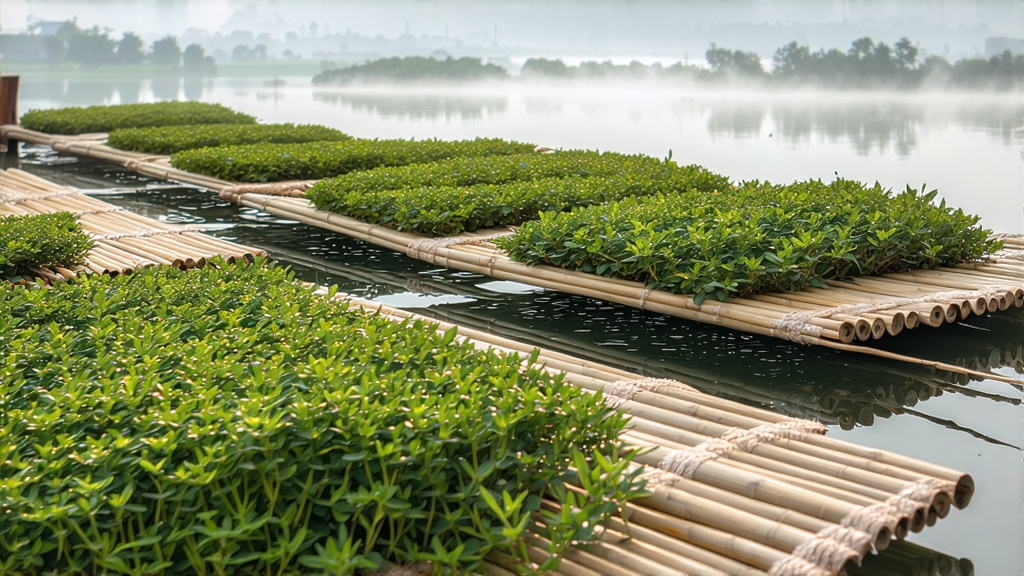
Biluochun, whose name translates literally to “Green Snail Spring,” is one of China’s ten most celebrated teas, yet it remains a quiet mystery outside serious tea circles. Produced only in a micro-zone of hills hugging eastern Taihu Lake in Jiangsu Province, this jade-green curl carries within its tiny spiral the perfume of fruit trees, lake mist, and six centuries of imperial lore. To understand Biluochun is to step into a landscape where tea bushes and peach, plum, and apricot trees share the same soil, where fishermen once burned straw to warn off frost, and where a single kilo of the finest grade can require sixty thousand hand-picked buds.
History: From Xiaoshi Hill to the Dragon Throne
The first written record appears in the Ming Dynasty “Tea Manual of Wu County” (1492), but legend pushes the origin back to the Yuan. A tea picker, running late, tucked fresh buds into her bosom; the warmth released an intoxicating aroma that startled passing monks. By the late 1600s the Kangxi Emperor, touring the south, tasted the tea at Xiaoshi Hill and renamed it Biluochun for its snail-like coil and early-spring harvest. Tribute status followed; every April, sealed bamboo tubes of the tea raced north by imperial courier, reaching Beijing while the leaves still smelled of lake fog.
Micro-terroir: Why Only Three Villages Matter
Purists draw an invisible triangle: Dongshan Peninsula, Xishan Island, and the tiny islet of Piaomiao. Granite parent rock, degraded into loose, slightly acidic loam, drains quickly yet retains just enough moisture. The lake acts as a thermal battery, cooling hot afternoons and warming frosty nights. More importantly, fruit trees interplanted since the Ming provide semi-shade, forcing the tea bushes to produce extra chlorophyll and volatile aromatics. When the spring sun hits, buds synthesize linalool and geraniol—the same compounds found in peach blossoms—creating Biluochun’s signature fruity bouquet.
Cultivars: Seedlings, Clones, and a Secret Third
The traditional cultivar is a seed-propagated landrace called “Xiao Ye” (small leaf), prized for slow growth and high fragrance. In the 1980s the Tea Research Institute released clone BXL-1, yielding 30 % more but losing some complexity. A third variant, “Red Heart,” sports a bronze-colored central vein and is reserved for pre-Qingming lots; its catechin-to-theanine ratio gives a sweeter, almost umami finish. Farmers often hedge their bets, blending all three in the same terrace to balance yield and aroma.
Craft: The Six-Motion Spiral
Picking begins when the overnight temperature stays above 5 °C and buds reach 1.5–2 cm, usually between March 20 and April 5. Only the “single spear” standard—one unopened bud—is accepted. Leaves are rushed downhill in shallow bamboo baskets lined with banana leaves to prevent bruising.
Withering is done outdoors for twenty minutes, just long enough for the lake breeze to reduce surface moisture by 10 %. Indoors, the tea is spread on rush mats under 18 °C and 65 % humidity; the goal is to soften cell walls without the grassy edge that plagues lesser greens.
Fixation employs a duck-egg-shaped wok heated to 180 °C. The tea master performs six synchronized motions: grab, toss, shake, roll, press, and flick. Each motion lasts three seconds and is repeated 120 times over seven minutes. The temperature drops 10 °C every minute, locking in green color while allowing partial oxidation of lipids that later translate into nutty notes.
Rolling is where the snail takes shape. Buds are placed in a cotton cloth pouch and twisted under palm pressure for twelve minutes, paused every two minutes to loosen and redistribute. The spiral tightens, trapping microscopic air pockets that will expand during brewing, releasing aroma in bursts.
Final drying uses a charcoal brazier topped with a horse-hair sieve; the fire is fed only with dried orange branches, whose oils scent the leaf subtly. Temperature hovers at 60 °C for forty minutes until moisture falls to 5 %. The finished tea resembles tiny jade snails, silvery tips peeping from dark green coils, smelling of lychee, magnolia, and fresh cream.
Grading: A Code of One, Two, Three
Grade 1 (Special Supreme) needs 60 % bud-to-leaf ratio, brewed liquor so pale it’s almost white